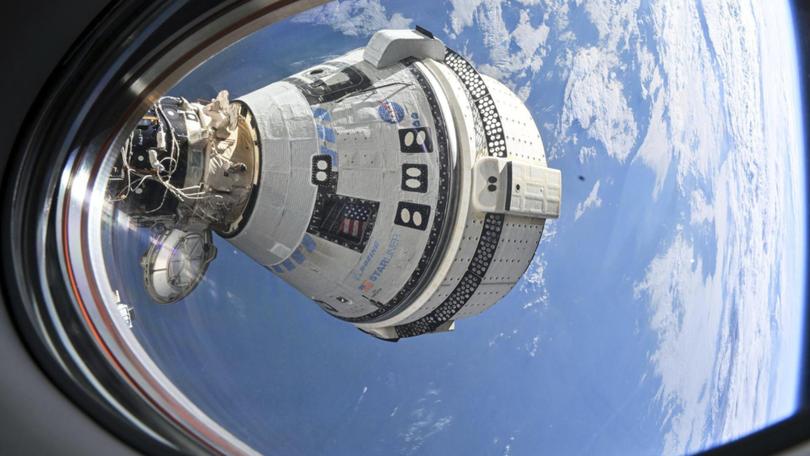Starliner astronauts: Suni Williams and Butch Wilmore share update saying ‘We always miss our family’

Nineteen astronauts across three spacecraft are in orbit around Earth — a record in the history of human spaceflight. Two of them, Suni Williams and Butch Wilmore of NASA, were not originally scheduled to be up there at this time.
But neither seems perturbed by that. The two astronauts expressed staunch support for NASA and Boeing, the company whose troubled spacecraft they rode to the International Space Station in June, before it returned to the surface uncrewed last week.
“This is my happy place,” Ms Williams said Friday at a news conference from the space station.
Sign up to The Nightly's newsletters.
Get the first look at the digital newspaper, curated daily stories and breaking headlines delivered to your inbox.
By continuing you agree to our Terms and Privacy Policy.“I love being up here in space. It’s just fun, you know?”
Mr Wilmore said he was not disappointed by NASA or Boeing or the decisions that led to their stay in orbit, which was originally announced as eight days in length but will now last until next year.
“Let down?” Mr Wilmore said.
“Absolutely not. Never entered my mind.”

In June, Ms Williams and Mr Wilmore launched into space on a test flight of Boeing’s Starliner. The vehicle was to be a second commercial option for NASA to send people to and from the International Space Station.
The spacecraft had suffered a series of technical hiccups across years of testing, including software errors, a faulty parachute system and a helium leak in the propulsion system used to manoeuvrer the capsule in space.
During the latest test flight, the first with astronauts aboard, more helium leaks sprang up once Starliner got to orbit.
After months of analysis, NASA officials announced in August that Starliner would be heading back to Earth uncrewed. The pair of astronauts watched from the space station’s cupola as their ship departed without them.
“I was so happy it got home,” Ms Williams said, adding that she felt a sense of relief, rather than disappointment, when it landed successfully in New Mexico last Friday.
Ms Williams and Mr Wilmore are now expected to return to Earth in February on a SpaceX Crew Dragon.
By that point, the duo will have been in space for eight months — though NASA objects to calling them “stranded.”
In the news conference Friday, the two astronauts shared some of the now-thwarted plans they had for the fall and winter.
“We always miss our families,” Ms Williams said, mentioning her mother, husband, two dogs and friends. Williams, who hails from Massachusetts, said that she would miss New England’s apple-picking season amid the red and yellow hues of autumn, but hoped to take pictures of it from space.
Mr Wilmore, who has a wife and two children back on Earth, will miss most of his younger daughter’s senior year of high school and his elder daughter’s sophomore year in college.
One thing they won’t miss is casting their votes in the November presidential election: Texas allows NASA astronauts to vote from space, and the ballots should arrive at the space station in a couple of weeks.
Ms Williams and Mr Wilmore are not the only astronauts to have had their stay in orbit unexpectedly extended by months.
A year and a half ago, a radiator on a Russian Soyuz spacecraft docked at the space station sprang a leak. Frank Rubio, a NASA astronaut who launched to the space station on that vehicle, and two Russian astronauts suddenly did not have a ride home.
As with Starliner, engineers analysed whether the Soyuz was safe enough to take the three back to Earth.
“There was no imminent threat to us as a crew, and so we could take the time to analyse, do different testing and really see what different options we could explore for us to get home,” Rubio recalled in an interview last month.
Ultimately, Russia launched a replacement Soyuz, and Rubio’s six-month stay was extended to more than a year. He let his wife and daughters know in a phone call. “It was challenging,” he said.
“You’re missing six extra months of events, right? So whether that’s birthdays, anniversaries or just special moments, it’s certainly a challenge.”
Rubio now holds the record for the longest single stay in space by an American astronaut: 371 days.
“Butch and Suni have exhibited the exact same positive attributes that I tried to do,” he said. “Positive attitude. Try to contribute to the work. Focus on the mission.”
Ms Williams and Mr Wilmore seem to be settling into their extended mission, which includes daily exercise to combat the effects of living in space and additional duties as full members of the space station’s crew. (Both have had previous stays on the outpost.)
Ms Williams is also keeping a weekly recap journal, which she sends regularly to loved ones back home. She views the opportunity for introspection in space as a silver lining.
“It really is difficult for me to imagine people on Earth not getting along,” she said. “It’s the one planet we have, and we should all really be happy that we’re there together because that’s it. That’s our place.”
This article originally appeared in The New York Times.
© 2024 The New York Times Company
Originally published on The New York Times
